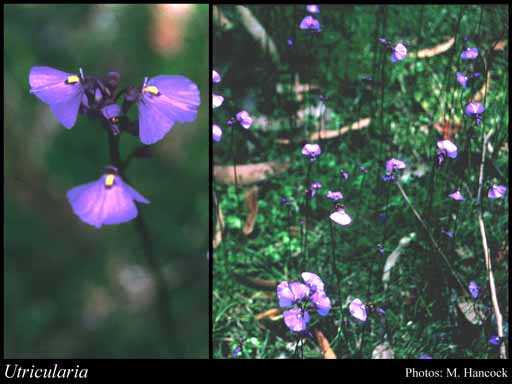- Reference
- Sp.Pl. 2:18 (1753)
- Name Status
- Current

Scientific Description
Family Lentibulariaceae.
Habit and leaf form. Herbs. ‘Normal’ plants, or plants of very peculiar form; often exhibiting no clear distinction between stems, roots and leaves, the stem bearing photosynthetic appendages equipped with animal-trapping bladders. Leaves well developed, or absent (some species). Plants rootless (without true roots, the stems modified in various ways to function as rhizoids and stolons); ‘carnivorous’. Trapping mechanism active, or passive. The traps in the form of minute (submerged) bladders. Annual, or perennial; plants with a basal concentration of leaves, or with neither basal nor terminal concentrations of leaves. When rooted/non-aquatic, self supporting, or epiphytic. Hydrophytic, or helophytic; when aquatic, free floating, or rooted. Leaves of hydrophytes submerged, or emergent. Heterophyllous (often, with both ‘modified’ and ‘normal’ leaves), or not heterophyllous. Leaves alternate, or opposite, or whorled; spiral; when identifiable ‘herbaceous’; petiolate, or subsessile; non-sheathing; when identifiable simple. Leaf blades dissected, or entire; when dissected, pinnatifid; pinnately veined. Leaves without stipules; without a persistent basal meristem. Stem anatomy. Nodes unilacunar. Secondary thickening absent.
Reproductive type, pollination. Fertile flowers hermaphrodite. Unisexual flowers absent. Plants hermaphrodite. Entomophilous.
Inflorescence and flower features. Flowers aggregated in ‘inflorescences’, or solitary (rarely); in racemes, or in panicles. The terminal inflorescence unit racemose. Inflorescences scapiflorous; axillary (or radical). Flowers bracteate. Bracts small, 1–3 at base of each pedicel. Flowers small to medium-sized; very irregular; zygomorphic. The floral asymmetry involving the perianth and involving the androecium. Flowers basically 5 merous; cyclic. Free hypanthium absent. Hypogynous disk absent. Perianth with distinct calyx and corolla; 4–9; 2 -whorled; isomerous, or anisomerous. Calyx 2, or 4 (subgenus Polypompholyx); 1 -whorled, or 2 -whorled (subgenus Polypompholyx); gamosepalous; blunt-lobed; imbricate, or open in bud; often slightly unequal but not bilabiate, or regular; persistent; usually slightly accrescent in fruit; at least theoretically with the median member posterior. Corolla 5 (at least theoretically), or 2 (sometimes, ostensibly); 1 -whorled; gamopetalous; imbricate; bilabiate (the upper lip erect, obtuse or notched, occasionally lobed; lower lip longer and broader, entire or lobed, produced into a concave protruding palate which more or less closes the throat); spurred (anteriorly, usually well developed but sometimes saccate or almost obsolete). Androecium 2. Androecial members adnate (to the base of the corolla tube); free of one another; 1 -whorled. Stamens 2; reduced in number relative to the adjacent perianth; more or less theoretically oppositisepalous; all alternating with the corolla members. Anthers connivent; dorsifixed; dehiscing via longitudinal slits; unilocular to bilocular (transversely constricted); tetrasporangiate. Gynoecium 2 carpelled (the posterior member represented by its reduced stigma). The pistil 1 celled. Carpels reduced in number relative to the perianth. Gynoecium syncarpous; synstylovarious; superior. Ovary unilocular; 1 locular. Gynoecium median (the stigmas one posterior, the other anterior). Ovary sessile. Gynoecium stylate. Styles 1; apical. Stigmas 1–2 (the posterior lobe more or less abortive); wet type; papillate; Group III type. Placentation free central. Ovules in the single cavity (2–)5–100 (i.e. to ‘many’); funicled, or sessile, or sunken in the placenta; non-arillate; anatropous.
Fruit and seed features. Fruit non-fleshy; dehiscent; a capsule. Capsules valvular (2–4 valves), or circumscissile. Fruit 1–100 seeded (i.e. to ‘many’). Seeds non-endospermic. Embryo rudimentary at the time of seed release; straight.
Physiology, biochemistry. Aluminium accumulation demonstrated.
Geography, cytology, number of species. Native of Australia. Not endemic to Australia. Australian states and territories: Western Australia, Northern Territory, Queensland, and New South Wales. Northern Botanical Province and South-West Botanical Province.
Taxonomic Literature
- Lowrie, Allen 2002. Utricularia petertaylorii (Lentibulariaceae), a new species from the south-west of Western Australia.
- Wheeler, Judy; Marchant, Neville; Lewington, Margaret; Graham, Lorraine 2002. Flora of the south west, Bunbury, Augusta, Denmark. Volume 2, dicotyledons. Australian Biological Resources Study.. Canberra..
- Lowrie, Allen 1998. A new species of Utricularia (Lentibulariaceae) from the south-west of Western Australia.
- Lowrie, Allen 1998. Carnivorous plants of Australia. Volume 3. University of W.A. Press.. Nedlands, W.A..
- Wheeler, J. R.; Rye, B. L.; Koch, B. L.; Wilson, A. J. G.; Western Australian Herbarium 1992. Flora of the Kimberley region. Western Australian Herbarium.. Como, W.A..
- Taylor, Peter 1989. The genus Utricularia : a taxonomic monograph. H.M.S.O.. London..